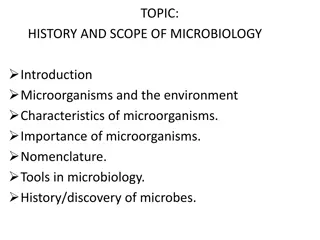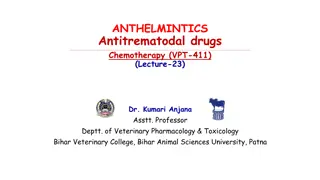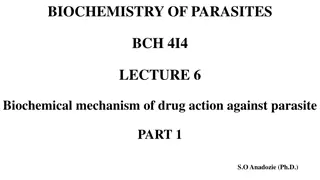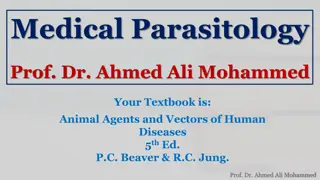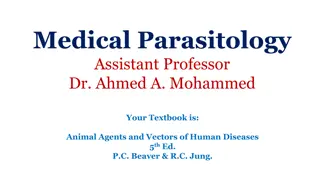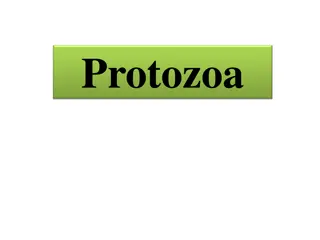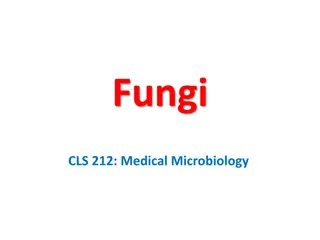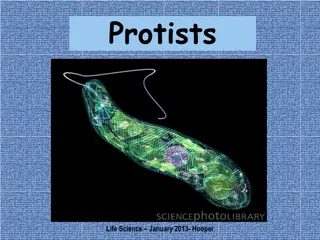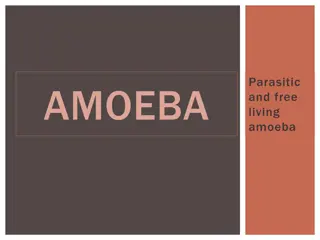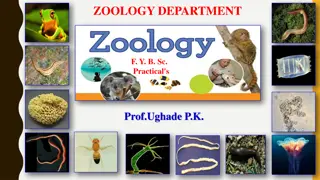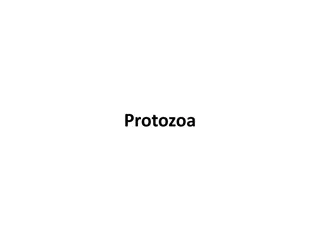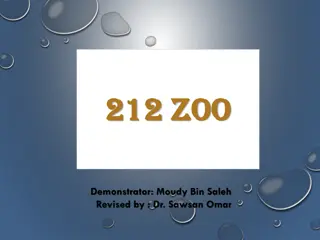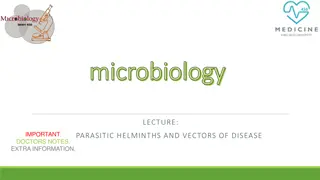Understanding Apicomplexa: The Intriguing World of Parasitic Protozoa
Apicomplexa, a group of unicellular, spore-forming parasites, exhibit a complex life cycle involving sexual and asexual stages. Coccidia, a type of Apicomplexan parasite, cause diseases like coccidiosis in humans and animals. The disease spreads through contact with infected feces or tissue, leading to symptoms like diarrhea. Different genera such as Cryptosporidium and Isospora play roles in human infections. Understanding the life cycles and structures of these parasites is crucial for effective management and prevention of associated diseases.
Uploaded on Oct 01, 2024 | 0 Views
Download Presentation

Please find below an Image/Link to download the presentation.
The content on the website is provided AS IS for your information and personal use only. It may not be sold, licensed, or shared on other websites without obtaining consent from the author. Download presentation by click this link. If you encounter any issues during the download, it is possible that the publisher has removed the file from their server.
E N D
Presentation Transcript
Apicomplexa Apical complex= apicoplast Unicellular, spore-forming Exclusively parasites (i.e., no free-living) Motile structures are absent except in certain gamete stages
Apicomplexa complex life-cycle sexual asexual (sporogony & (schizogony or gametogony) merogony)
GENERAL APICOMPLEXAN LIFE CYCLE gametocytes zygote GAMETOGONY SPOROGONY merozoites sporozoites MEROGONY
Apicomplexa Piroplasms Babasia Microsporidia Neuplasms Gregarines COCCIDIA Cryptosporidium Isospora Toxoplasma Sarcocystis Haemosporina Plasmodium spp
Coccidia Are microscopic, spore-forming, single-celled parasites. Are obligate, intracellular parasites (they must live and reproduce within host cells). Coccidiosis is a parasitic disease of the intestinal tract of humans and animals, caused by coccidian protozoa belong to four genera: Cryptosporidium sp., Isospora belli, Sarcocystis andToxoplasma gondii).
The disease spreads from one host to another by contact with infected feces, or ingestion of infected tissue. Diarrhea, which may become bloody in severe cases, is the primary symptom. Only two species of coccidia known to undergo schizogony and gametogony in man,viz., Isospora belli & Cryptosporidium.
GENERAL APICOMPLEXAN LIFE CYCLE zygote gametocytes GAMETOGONY SPOROGONY merozoites sporozoites MEROGONY
The infective oocysts in species of Isospora belli andSarcocystis produce two internal sporocysts, each with four sporozoites; in Cryptosporidium the sporocyst stage is omitted. characterized by thick-walled oocysts excreted in feces
Cryptosporidium cryptosporidiosis
Cryptosporidium First human case reported in 1976 Fecal-oral transmission (monoxenous) Initially it was believed to be a rare and exotic infection. Now recognized as a common human pathogen and a frequent cause of diarrhea in humans.
Cryptosporidium Self-limiting diarrhea in immunocompetent persons Profuse, watery diarrhea associated with AIDS (life threatening) Cryptosporidium parvum, C. muris and C. hominis
feces or respiratory secretions
Cryptosporidium Life Cycle Merogony = schizogony produce merozoites Gametogony = gamogony or = gametocytogenesis produce micro- and macrogametes Sporogony produce sporozoites completed on host cell thin (autoinfection) or thick walled oocysts
Extracytoplasmic Location microvilli extend and fuse to enclose zoite close association between parasite and host intestinal epithelial cell called adhesive zone, feeder organelle, etc
PATHOGENESIS The most common clinical manifestation of cryptosporidiosis is a mild to profuse watery diarrhea. This diarrhea is generally self-limiting and persists from several days up to one month. Recrudescences are common.
PATHOGENESIS Abdominal cramps, anorexia, nausea, weight loss and vomiting are additional manifestations which may occur during the acute stage. The disease can be much more severe for persons with AIDS which manifests as a chronic diarrhea lasting for months or even years.
Pathogenesis DIARRHEA Epithelial cells damaged or killed villus atrophy (blunting) Na+ absorption intercellular permeability crypt cell hyperplasia Cl- secretion inflammation in lamina propria enhanced secretion of antibodies (IgA)? epithelia malfunction (osmotic) impaired absorption enhanced secretion inflammatory diarrhea mucosal invasion leukocytes in stools secretary diarrhea toxin associated watery
Epidemiology Fecal- oral disease. 2 major genotypes identified: genotype 1= C. hominis only human sources non-infective for mice or calves anthroponotic transmission genotype 2= C. parvum human and bovine sources infective for mice and calves zoonotic transmission
Factors Favoring Waterborne Cryptosporidiosis small size of oocysts (4-5 m) reduced host specificity and monoxenous development close associations between human and animal hosts large number of oocysts excreted (up to 100 billion per calf per day) low infective dose (<30) robust oocysts; resistant to chlorine
Diagnosis demonstration of typically shaped oocysts in stool examination. Treatment fluid and electrolyte replacement In immunocompetent persons is self- limited diarrhea Control Improvement in sanitary and hygienic conditions is indicated.
Isospora belli wide geographical distribution (higher prevalence in warmer areas) monoxenous, probably not zoonosis, occurs via the oral-fecal route. invades intestinal epithelial cells of S.I. and produces self limiting diarrhea in normal individuals.
Isospora belli symptoms range from mild gastro-intestinal distress to severe dysentery often self-limiting, but can become chronic (wasting, anorexia) symptoms more severe in AIDS patients
Life cycle of Isospora belli in soil: sporogony (sexual) end by formation of oocyst containing 8 sporozoites in human intestine: schizogony (asexual) transformation of sporozoites into schizontes and merozoites gametogony(sexual): transformation of merozoites into male & female gametocytes
Isospora belli 2 sporocysts4 sporozoites each (30 x 12 mm oocyts)
Pathology In immunocompetent: acute, non bloody diarrhea crampy abdominal pain can last for weeks and result in malabsorption and weight loss. In immunodepressed patients, and in infants and children, the diarrhea can be severe
Diagnosis Microscopy (demonstration of typically shaped oocysts) Treatment Trimethoprim- is the drug of choice Control Improvement in sanitary and hygienic conditions is indicated.


